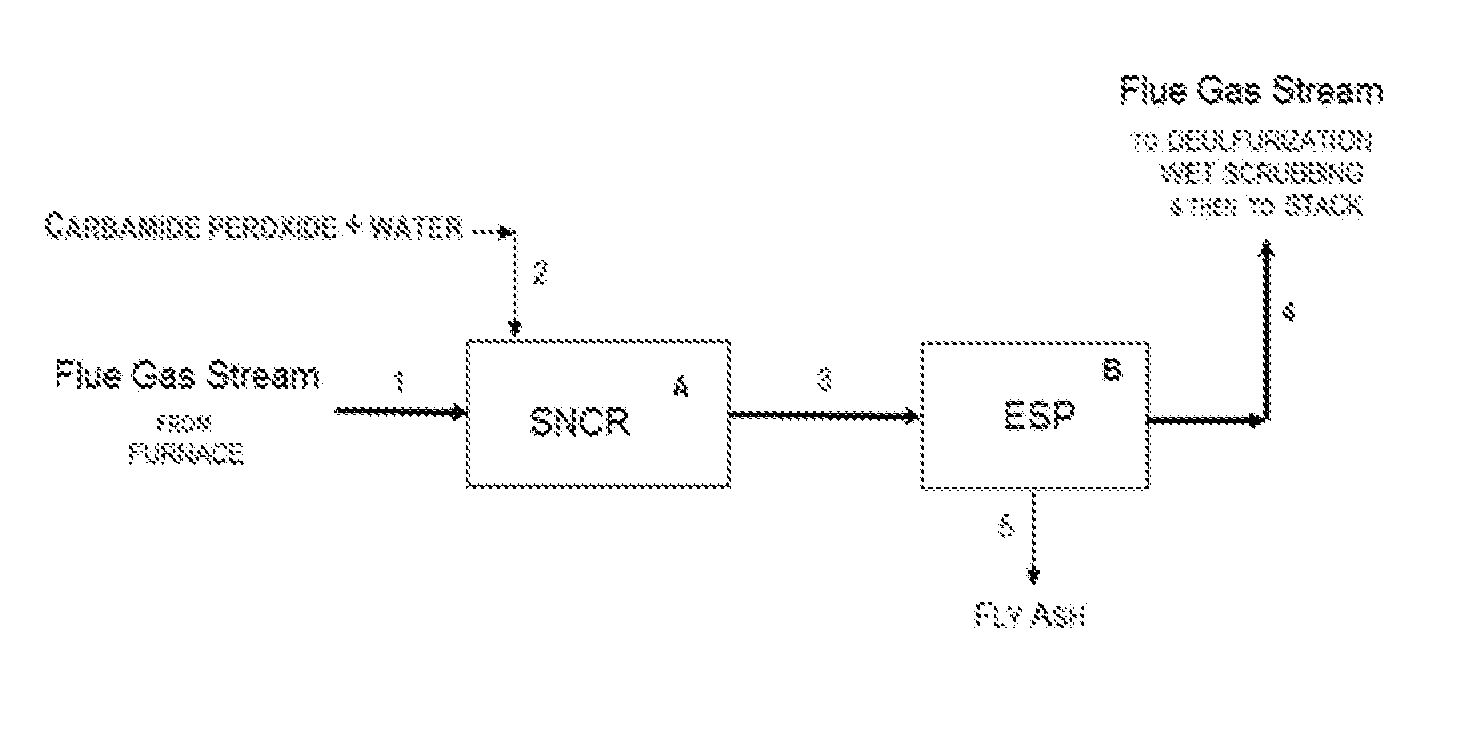Treatment of nitrogen oxides in flue gas streams
a technology of flue gas stream and nitrogen oxide, which is applied in the direction of dispersed particle separation, chemistry apparatus and processes, and separation processes, etc., can solve the problems of brown plume, wet scrubbing desulfurization techniques used for so/sub>x /sub>removal of combustion flue gas, and the presence of pollutants in the combustion flue gas stream
- Summary
- Abstract
- Description
- Claims
- Application Information
AI Technical Summary
Benefits of technology
Problems solved by technology
Method used
Image
Examples
example 1
[0102]Examples 1-3 utilized the following laboratory apparatus. The lab set-up included a pre-heater consisting of a quartz tube heated by a Lindberg tube furnace; an insulated heated tube reactor (diameter: 10 mm, length: 1,200 mm); and auxiliary equipment including a syringe pump, temperature controllers, gas flow meters, gas distribution panel, cold trap, and mist catcher.
[0103]A gas mixture consisting of NO, O2, and N2 was introduced as a gas stream first into the pre-heater and then into the insulated heated tube reactor heated to a predetermined temperature. The gas components of the gas mixture were sourced from nitrogen gas, air, and NO in nitrogen (390 ppm NO in N2). Concentrations of each component in the gas mixture were adjusted by a flow rate meter.
[0104]An injection inlet was provided at a position at the entrance to (upstream of) the insulated heated tube reactor, and aqueous urea-H2O2 reagent solutions were injected into the flowing gas stream through a stainless ste...
example 2
[0115]Example 2 studied the effect of using three different urea-to-hydrogen peroxide molar ratios on the removal of NO from a gas stream. The apparatus used for Example 2 was the same as that utilized in Example 1.
[0116]In Example 2, the urea (in solid form) or hydrogen peroxide (50% H2O2 source solution) was combined with carbamide peroxide and water to prepare aqueous solutions containing urea and hydrogen peroxide in three different molar ratios: 1.5:1, 1:1 and 0.67:1 urea:H2O2 in the aqueous reagent solutions.
[0117]All of these aqueous solutions, however, contained 5.0 wt. % urea—hydrogen peroxide reagent, the same solution concentrations of urea and hydrogen peroxide (corresponding to 3.2 wt. % urea and 1.8 wt. % H2O2) as were used in Example 1.
[0118]The molar ratio of H2O2:NO was kept constant in Example 2 at 2:1 H2O2:NO, so only the urea was varied with respect to the inlet NO concentration in these studies.
[0119]The temperature of the gas stream in the tube reactor was 405°...
example 3
[0123]Example 3 studied the effect of gas stream temperature on the removal of NO from a gas stream, under otherwise fixed operating conditions, using the same urea-to-hydrogen peroxide molar ratio and hydrogen peroxide to NO molar ratio in each of the six temperature studies.
[0124]The apparatus used for Example 3 was the same as that utilized in Examples 1 and 2.
[0125]In Example 3, as in Example 1, the aqueous solution of the reagent was prepared by dissolution of carbamide peroxide, a solid adduct of urea and hydrogen peroxide, in water to prepare an aqueous solution that contained 5.0 wt. % carbamide peroxide, corresponding to 3.2 wt. % urea and 1.8 wt. % H2O2.
[0126]The molar ratio of urea to hydrogen peroxide in the aqueous reagent solution was therefore 1:1 urea:H2O2, as was the case in Example 1. The aqueous reagent solution was introduced into the gas stream in an amount that provided 2 moles of hydrogen peroxide to each mole of NO in the inlet gas stream. The ratio of urea t...
PUM
| Property | Measurement | Unit |
|---|---|---|
| temperature | aaaaa | aaaaa |
| temperature | aaaaa | aaaaa |
| temperature | aaaaa | aaaaa |
Abstract
Description
Claims
Application Information
 Login to View More
Login to View More - R&D
- Intellectual Property
- Life Sciences
- Materials
- Tech Scout
- Unparalleled Data Quality
- Higher Quality Content
- 60% Fewer Hallucinations
Browse by: Latest US Patents, China's latest patents, Technical Efficacy Thesaurus, Application Domain, Technology Topic, Popular Technical Reports.
© 2025 PatSnap. All rights reserved.Legal|Privacy policy|Modern Slavery Act Transparency Statement|Sitemap|About US| Contact US: help@patsnap.com



